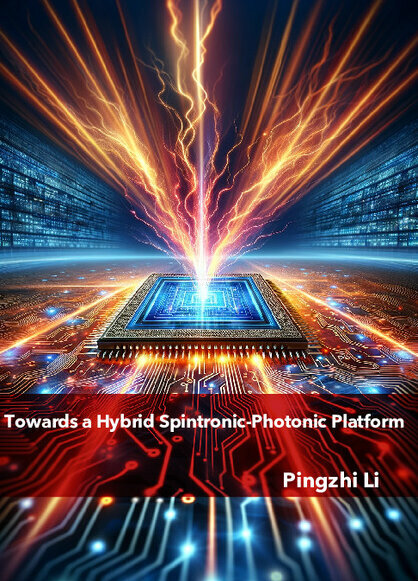A quest for hybrid spintronic-photonic technology
Pingzhi Li defended his PhD thesis at the Department of Applied Physics and Science Education on February 28th.
![[Translate to English:] [Translate to English:]](https://assets.w3.tue.nl/w/fileadmin/_processed_/0/b/csm_Pinghzhi%20Li%20Banner%20image%20OPT2_6184815ab6.jpeg)
Over the past three decades, integrated chip technology, propelled by Moore's Law, has been reshaping our world. However, as Moore's Law decelerates, researchers are exploring alternatives with spintronics and integrated photonics are among the most popular choices. For his PhD research, Pingzhi Li looked at the heterogeneous integration of electronics, photonics, and spintronics within a single chip. This fusion is not merely about combining different technologies; it's about creating synergy that capitalizes on the unique strengths of each domain, addressing their individual limitations, and reducing the energy and speed losses typical in conventional inter-platform interactions.
At the heart of the study of Pingzhi Li is the use of a synthetic spintronic ferrimagnetic material, which is made up of layers of 3d ferromagnetic cobalt and 4f rare-earth ferromagnetic gadolinium. These layers are antiferromagnetically coupled, allowing for two essential effects.
First, the spintronic manipulation of magnets by current is highly efficient in terms of energy and speed. Second, its magnetization can be switched by a short laser pulse within one picosecond, a process known as all-optical switching (AOS). A device built on this material platform enables seamless integration of electronics, spintronics, and photonics.
Spintronic device
Previous studies have demonstrated many promising AOS, such as ultrahigh speed and low energy consumption using free space light on full films. These demonstrate applications of the technology in spintronic-photonic memory. This device requires photonic manipulation of a spintronic device in a high-speed, energy-efficient, and spatially compact manner, logically leading to the use of integrated photonics.
A key highlight of Li’s research is the experimental demonstration of AOS in a spintronic device within an integrated photonic circuit using LionIX International’s SiN technology. By integrating a spintronic reading device made of the synthetic ferrimagnet atop a photonic waveguide, Li and his collaborators ensured that the spintronic device absorbs the energy of light pulses, inducing AOS.
The change in magnetization is successfully read out by the spintronic magneto-resistance. This demonstration not only showcases the materials' potential, but also proves the practical feasibility of merging spintronics and photonics, bridging a substantial gap in technology.

Application
A primary application of spintronics is creating ultrafast, energy-efficient on-chip memory, potentially supplanting SRAM and DRAM. One notable spintronic device concept is the racetrack memory, which encodes data as a sequence of magnetic domains in a magnetic wire. Current passing through the wire moves these domains coherently along it.
Li’s synthetic ferrimagnet-based racetrack memory can be all-optically switched, combining the benefits of spintronics and integrated photonics. Another significant advancement in Li’s research is improving the domain motion velocities in the racetrack memory for higher data rates and energy efficiency. He experimentally and theoretically achieved this by fine-tuning the composition at the nanoscale to nullify the net magnetization, significantly enhancing spin torque efficiency and achieving domain velocities above 2000 m/s.
Enhancement
Additionally, Li made strides in enhancing AOS energy efficiency through optical principles of anti-reflecting and interface modification via He irradiation. The optical method concentrates light by optimizing reflection and transmission, while He irradiation promotes interlayer momentum transfer efficiency. These techniques have been shown to significantly boost AOS energy efficiency, inspiring the localized on-chip creation of magnetic domains.
Finally, Li’s photonic designs incorporate plasmonic concepts to enable switching of spintronic devices below 50 nm, considering the technological limitations of established InP integrated photonic platforms. This is a breakthrough, as conventional integrated photonic waveguide photons are limited by diffraction and are typically an order of magnitude larger than 50 nm.
Optimism
In conclusion, Li’s research optimistically posits that his hybrid spintronic-photonic concept, underscored by the AOS demonstration in integrated photonic circuits, holds significant promise.
It aims to garner interest from the nanomagnetism and nanophotonic communities, encouraging them to combine their research efforts towards realizing impactful integrated applications to address ongoing challenges in Information and Communication Technology (ICT).
Title of PhD thesis: Towards a Hybrid Spintronic-Photonic Platform. Supervisors: Bert Koopmans and Reinoud Lavrijsen.